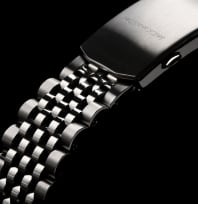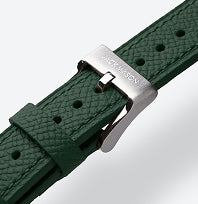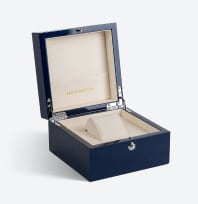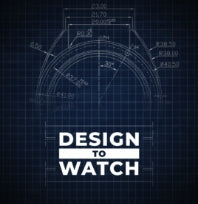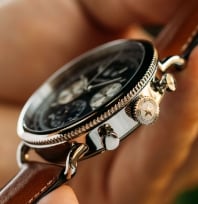When getting into the horological world, plenty of terms exist to demarcate different types of watches. Dive, sport, pilot, aviator, racing, and dress watches all see regular use and see some overlap between their designs. One of the most ubiquitous types of watch is the chronograph watch, named for the Greek personification of time itself.
Chronograph watches are separated from other watches due to their function. The other specified timepieces refer to a mixture of functional and design characteristics. Chronograph watches are defined by one thing alone: The presence of a chronograph in a watch. Chronographs can be integrated into any style of watch as a result of this.
There is a reason that this type of timepiece is popular. They are visually distinctive and feature one of the most versatile watch complications in history.
Below, we’re going to explain the fine details of what a chronograph watch is and does. Once that is done, we’ll highlight a few timepieces with wildly varying aesthetics in chronograph wristwear.
What Is a Chronograph?
A chronograph watch is composed of two primary components: A chronograph and a tachymeter. The modern chronograph is read from subdials in a watch, whereas a tachymeter is read from the bezel.
It is possible to find watches that lack a tachymeter, but it’s rare to find a tachymeter watch sans chronograph. Both of these timepieces originated as independent items which were later integrated into watches.
Chronographs
Chronographs are used to measure time like a stopwatch, which is fitting given that the term literally means “time writer.” The original chronograph in 1816 was composed of a paper circle and pen, which rotated to create physical marks. This timepiece was used to chart the movement of the stars.
Five years later, King Louis XVIII commissioned a special chronograph to time horse races. This specialized use of chronograph functionality holds true today, as independent stopwatches are still used in races. In the 20th century, as chronographs were integrated into watches, they saw use in military ventures.
Light travels faster than sound. For this reason, it’s possible to estimate the distance of a lightning strike by the difference in time until thunder sounds. The same principle can be applied to the sound of artillery strikes in the distance or generally to time maneuvers. For its rich application, the chronograph is, bar none, the most versatile complication.
Modern chronograph watches utilize subdials in different ways to measure long periods of time. Generally, the large second hand is used to measure seconds, while separate subdials count minutes and hours. A third subdial will often track seconds in the normal function of the watch.
Chronograph pushers, which control the complication, operate differently based on the model. The pusher is most often found at the 2 o’clock position. Pushing it once starts the timer and pushing it again usually stops it. A third push may then restart it, though each chronograph operates differently.
The Tachymeter
The cousin to the chronograph is the tachymeter. Whereas the chronograph measures time (and in some cases can calculate distance), tachymeters measure speed over distance. Speed is able to be calculated no matter what the unit is, as long as the rough distance is known. Tachymeters are most often found on the bezel of a watch or the outer circumference of a dial.
In order to explain the tachymeter, a simple mathematical formula needs to be explained. Distance traveled divided by time elapsed equals average speed. Distance has to be calculated outside the complication, but inputting time elapsed gives a speed reading, in “X units per hour.” Hours can be converted to minutes by dividing a given reading by 60.
Because of the nature of a tachymeter scale, tachymeters are best used to measure fast objects or short distances. Tachymeter scales usually begin between 400 and 1000 units depending on the position on the watch the scale starts at.
This is because as time elapsed increases, speed decreases, according to the formula above. The pusher for this complication is usually below the crown, around the four o’clock position on a watch.
To give an easy example of how to use a tachymeter, imagine you are doing a lap around a racetrack. As you start a lap, you press the pusher to begin the tachymeter and press it again as your lap finishes. Your second press came at the 60-second mark, and you know the racetrack to be one mile long. Your speed, dividing distance by time, is one mile per minute, or 60 miles per hour.
A tachymeter is a far more specialized tool than a chronograph. Despite this, it is an essential complication for racers, boaters, and anyone who values speed.
Halyard Chronograph
We previously stated that many watch types have some sort of overlap. The result of this can be seen where nautical and chronograph watches meet in the Halyard Chronograph.
This multipurpose watch has a name derived from sailing terminology and a caseback revealing an anchor flanked by ocean waves. The bezel grades softly inward to meet the crystal, showcasing a tachymeter scale printed on the edge of the dial.
The chronograph of the watch utilizes two subdials embedded into the dial at the 3 and 9 o’clock positions. A third, at the 6 o’clock position, is printed onto the dial itself. The first two subdials feature hands colored to match the primary dial hands, while the third subdial has a half-red hand. The printed-on nature of the third dial allows added function in the form of a carefully placed date window.
As a sports watch, performance under duress is key. This particular timepiece has water resistance testing at 100 meters and a scratch-resistant sapphire crystal. A stainless steel 316L case offers supreme corrosion resistance whether exposed to droplets on land or full immersion at sea.
Advanced Options
The Halyard Chronograph comes in five different colorways to match every sense of style.
- The white dial with tan leather strap, linked above, uses white, pearlescent, and black design motifs to enhance red accents.
- The sky blue dial with tan leather strap uses bright visuals and silvery subdials for a glimmering approach to nautical style.
- The navy dial and brown leather strap use dark visuals for a sharp contrast in business or casual settings.
- The black dial and black leather strap allow for the brooding allure of monochrome aesthetics.
- The last features a 24kt rose gold PVD plated case and multicolored dial.
The powerfully made Halyard Chronograph has visual components to fit any occasion and design elements needed to fit any environment.
Solar Chronograph
The next watch leaves behind oceanside visuals for a language inspired by mountainside vistas and long days camping out. Despite this new focus, the importance of our oceans still has significant input in the design of the Solar Chronograph. This watch is separated from others both by an outgoing design and by a special movement.
True to its name, the watch is powered by a solar movement that gains its charge through a uniquely textured, perforated dial. Though it is a chronograph watch, another complication defines this piece. At the 6 o’clock position is a functional alarm, perfect for reminders or for those sleeping close to their timepiece.
The distinctive design and goals in this sustainable watch go far beyond the movement. Every year, eight million of tons of plastic enter the ocean. The Solar Chronograph in both design and sales seeks to alleviate the issue. 10% of the profits from each watch benefit the Jan & Oscar Foundation, which benefits communities worldwide and spearheads ocean-cleaning endeavors.
Recycled materials and an active approach to wristwear form the cornerstone of the watch. The case is cast recycled, and the strap is made from recycled ocean plastic. A rotating compass bezel matches a compass-shaped second hand and north-facing caseback embossed on a topographic map.
Make It Yours
Three versions of the Solar Chronograph exist, with the same recycled principles behind each one:
- The green dial features a hunter-and-navy strap and steel case for an appearance that evokes the rawness of nature.
- The grey dial features a gunmetal PVD-coated case and gray-green interlaced strap for an industrial appearance on the wrist.
- The black dial highlights black PVD plating and the dark strap, which combines with bright lettering for an impressive contrast.
Knowing Your Chronograph
The chronograph, as a standalone tool and an important component in horology, has seen numerous applications. They have served us from the orbit of the stars to the thrill of racing to the heart of combat. Today, watches are defined not only by their complications, but by the sense of aesthetics guiding their design.
A good chronograph watch is highlighted by its complication—but not defined with it. A strong sense of purpose is important in a watch. This can be showcased in the visual appeal of a timepiece or the design principles which set it apart.
Wherever you go, and however often you use your chronograph, know that it has been breaking horological barriers since 1816.
Sources:


